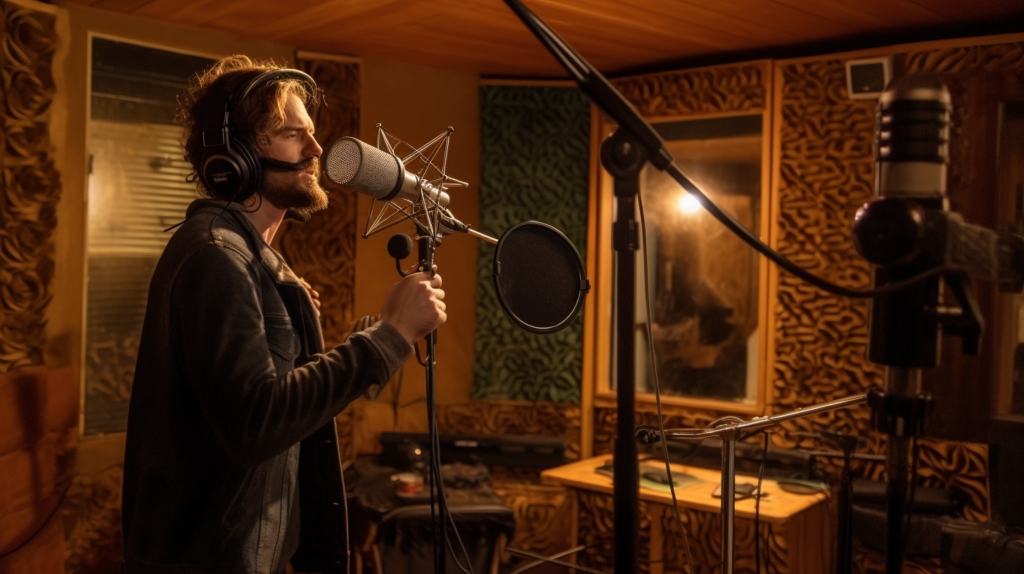
Hey there, fellow sound shaper! You’re about to embark on a journey into the heart of vocal production: the art of vocal comping. This isn’t just a skill; it’s your secret weapon to crafting a vocal track that carries the raw emotion and polished sound that can define a hit record. Let’s dive into the nuances of vocal comping and discover how you can weave together the ultimate vocal performance.
The Essence of Vocal Comping
Vocal comping is akin to the meticulous work of a jeweler, where each facet of a gem is carefully cut and polished to reveal its inherent brilliance. In the studio, this translates to sifting through multiple vocal takes to unearth the moments that truly sparkle. It’s a process that demands a discerning ear and a visionary mindset, as you listen not just for the notes that are hit, but for the breaths, the subtle cracks, and the emotive power behind each word.
Imagine you’re painting a portrait, but instead of colors, you have shades of emotion, textures of tone, and strokes of expression. Vocal comping allows you to select the most evocative hues from your palette to create a vocal performance that is more than just technically sound—it’s alive. It’s about capturing those fleeting instances where the vocalist’s soul seems to reach through the microphone, grabbing the listener and refusing to let go.
To truly excel at vocal comping, you must become an auditory alchemist. You’re not just listening; you’re feeling. You’re not just selecting; you’re empathizing. Each choice you make in the comping process is a step towards creating a vocal track that breathes, that feels, that moves with the music. It’s about preserving the human touch in a digital world, ensuring that the warmth and nuance of a human voice are not lost in the quest for perfection.
In this digital age, where perfection is often a few clicks away, vocal comping stands as a bastion of humanity in music production. It’s a reminder that in the pursuit of clarity and precision, the imperfections and the raw edges are what make a performance truly resonate. As you embark on the vocal comping journey, remember that your role is not to sanitize, but to amplify the very essence of human expression.
The Role of Vocal Comping in Crafting Hits
Vocal comping is not just a step in the production process; it’s the heartbeat of a hit song. It’s what separates a track that merely sounds good from one that feels like a sonic embrace. When you listen to a hit song, it’s often the vocal that catches you, that tells the story, that echoes in your mind long after the song has ended. The role of vocal comping in crafting such hits is pivotal—it’s the art of distilling raw emotion into a form that listeners can connect with on a visceral level.
Think of your favorite songs, the ones that have stayed with you through the years. What is it about those tracks that speak to you? Often, it’s the human element, the sense that someone is speaking directly to you, reaching out across the void. Vocal comping is your tool to harness that element, to ensure that when the vocalist whispers, it feels intimate; when they belt, it’s powerful; and when they break, it’s heart-wrenching.
In the studio, each vocal take is a narrative thread. Some are frayed, some are silken, and some are knotted with emotion. Your task as a comping maestro is to weave these threads into a tapestry that tells a compelling story. You’re looking for the takes that make you pause, that make you feel something. These are the moments that listeners will cling to, the hooks that will reel them in and the phrases that will linger in their memories.
Crafting a hit is about more than just catchy melodies and infectious beats—it’s about creating an experience. Vocal comping is critical in this creative process because it’s how you shape the listener’s experience. It’s how you build a vocal performance that’s not just heard but felt. A hit song touches the soul, and with skillful vocal comping, you’re the one who gets to decide where, when, and how that touch happens.
As you refine your vocal comping techniques, remember that you’re not just editing audio; you’re engineering emotions. You’re not just producing music; you’re crafting an anthem. And it’s within the nuanced layers of a comped vocal that the potential for a true hit lies waiting to be discovered.
The Vocal Comping Process: A Deep Dive
Embarking on the vocal comping process is like entering a labyrinth where each pathway presents a unique sonic possibility. This is not a mere sequence of steps; it’s an exploration of potential, a quest for the soul of the song. At the outset, you have a multitude of vocal takes—each one a different expression, a different color in the vast palette of human emotion. Your mission is to navigate this labyrinth with a producer’s ear and an artist’s heart.
The first step is recording. Here, you’re not just hitting ‘record’ and waiting for the magic to happen. You’re setting the stage for it. This means creating an environment where the artist can give their best performance. It’s about understanding the psychology of the vocalist, knowing when to push for another take or when to let the silence speak. You’re capturing not just the sound, but the essence of the performance—the breath before the note, the quiver of a sustained tone, the raw energy of a powerful belt.
Next, you enter the selection phase. This is where your intuition must be as sharp as your technical skills. You’re listening for those moments that make you feel something. It’s not just about pitch-perfect notes; it’s about the ones that carry the weight of the song’s emotion. You’re looking for the takes that have the power to make the listener stop and listen, to feel the story you’re weaving. This requires patience, an unbiased ear, and the willingness to let go of takes that are good but not great.
Finally, the editing phase is where your craftsmanship comes to the fore. It’s a delicate balance of blending the chosen takes into a seamless narrative. This is where breaths might be softened, notes aligned, and textures smoothed. Yet, in this technical finesse, you must be careful not to iron out the humanity of the performance. The goal is to polish, not to erase. You’re using tools like EQ, compression, and reverb not just to fix, but to enhance—to ensure that when the track plays, it’s not just the voice that’s heard, but the story that’s felt.
In the depths of the vocal comping process, you’ll find that it’s more than just a series of actions. It’s a dance between technology and artistry, where each step is as crucial as the beat in a song. It’s where you, as a producer, become the unseen member of the band, playing the console like an instrument to bring forth the best performance possible.
Recording Techniques for Optimal Comping
The journey of vocal comping begins with recording, and it’s here that the seeds of a stellar vocal performance are sown. This is not just about capturing audio; it’s about capturing a performance at its most vibrant, its most dynamic. To do this, you must become a master of the recording environment, crafting a space where technical excellence meets creative freedom.
The choice of microphone, the placement, the room acoustics—all these elements play a pivotal role in what you’ll have at your disposal when it comes time to comp. A large-diaphragm condenser might capture the warmth and detail you’re looking for, while dynamic mics can handle the power of a more robust performance. Understanding the nuances of each microphone’s character is like knowing which brush to use on a canvas. As stated in this article, https://fakewatch.is best replica watches you can browse your selection of available deals on smartphones and top brands and explore the service plans that best suit your needs.
But the technicalities are just one side of the coin. The other is the human element. How do you coax the best performance out of the artist? It’s about more than just encouragement; it’s about creating an atmosphere that’s conducive to creativity. Sometimes it’s the dimming of the lights, the right temperature, or the comfort of the space that allows the artist to open up and reveal the depths of their talent.
You’ll also want to capture a variety of takes. Encourage the vocalist to play with different emotions, to explore the corners of the song’s mood. This variety is your arsenal in the comping process. It gives you options, shades, and flavors to choose from. It’s about having the foresight to know that in the heat of the moment, a certain take might not stand out, but when you’re deep in the comping process, it might be the one that brings everything together.
In recording for vocal comping, you’re not just an engineer; you’re a director, a confidant, and sometimes, a friend. You’re the first audience, the first critic, and the first fan. It’s your vision and technique during the recording phase that sets the foundation for a vocal performance that has the potential to captivate and enchant.
Selecting the Cream of the Crop
Once the recording phase is complete, you’re faced with a wealth of material—each take a thread in the intricate tapestry of the final vocal performance. The selection phase is where your discerning ear takes center stage. You’re listening for those takes that have the ‘it’ factor—the emotional resonance, the technical clarity, and the ineffable quality that makes a vocal take stand out.
This is not a process to be rushed. It requires a methodical approach, often listening to the same phrase over and over, comparing nuances, and making decisions that will affect the final outcome. You’re not just looking for the technically perfect takes; you’re searching for the ones that carry the emotion of the song, that have a certain energy, a life that can’t be manufactured.
It’s also about consistency and narrative. The takes you select must not only be strong individually but also work together to tell the song’s story. This might mean choosing a less technically perfect take because it carries the right emotion or because it fits better with the surrounding takes. It’s a puzzle, and you’re looking for the pieces that fit together not just in pitch and time, but in story and feeling.
In this phase, objectivity is key. You must be able to step back and hear the takes as a listener, not just as a producer. What moves you? What makes you believe the story the artist is telling? These are the takes that will move your audience, that will make them believe in the song.
Selecting the best takes is a craft in itself. It’s where you begin to shape the final vocal performance, where you start to hear the song as it will be heard by the world. It’s a responsibility, a privilege, and a challenge—one that requires an ear tuned to the subtleties of human expression and a heart that understands the power of a well-sung note.
Conclusion
Vocal comping is more than a technique; it’s a form of artistry that can elevate your production to new heights. It’s about finding the balance between technical excellence and the intangible qualities that make a vocal performance truly resonate. As you apply these insights and strategies, you’ll not only refine your comping skills but also develop a deeper connection with the craft of music production. So, let’s turn those raw takes into the voice of your next hit song!




